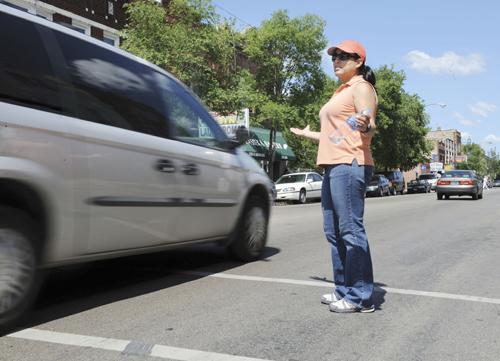Undercover police remind drivers to watch for pedestrians

Chicago Police Officer Grace Delgado, posing as a pedestrian in an undercover operation, throws up her hands as a van whizzes by her in a crosswalk in Chicago on June 17. The van was pulled over and given a warning ticket during the operation to call moto Rich Hein, The Associated Press
July 14, 2008
CHICAGO – One driver saw the pedestrian in the crosswalk but hadn’t heard about the “new” law requiring him to stop. Another knew about the law but didn’t see the pedestrian.
Motorists offered all kinds of explanations after being pulled over recently by Chicago police for driving past, around – and a few times nearly through – an undercover officer posing as a pedestrian trying to make her way across a busy street.
So, why did officer Grace Delgado try to cross the road? To remind motorists that the law requires them to yield whenever anyone takes a single step into a crosswalk.
Chicago this year joined a growing number of big cities and small towns that are sending undercover officers into traffic to get drivers to start looking out for pedestrians and start caring about them – or at least about their own wallets.
Two hours after Delgado started, 78 cars, trucks, vans and cabs had been pulled over for failing to yield. That number easily could have been doubled, but police stopped only motorists who kept driving after Delgado had made it four or five feet into the road.
Get The Daily Illini in your inbox!
“People, they don’t care,” said Delgado, whose bright pink baseball hat and orange blouse made her especially tough to miss. “It’s ‘Get out of my way.’ The whole mentality is ‘Get out of my way.'”
She may be on to something. According to the most recent statistics compiled by the National Highway Traffic Safety Administration, nearly 4,800 pedestrians were killed and 61,000 injured in 2006. In Chicago alone, 65 pedestrians have died annually in recent years.
Although the number of pedestrian deaths have dropped in recent years, there is a concern they could rise again if the number of vehicles continues to climb, and the elderly population skyrockets.
“We’re beginning to see a healthy desire of older folks to remain active and go out for their daily walks,” said Doug Hecox, spokesman for the Federal Highway Administration. “That, along with more cars … is a recipe for danger.”
Some communities already are seeing more walkers because of the slow economy.
“The way gas prices are, people are rediscovering their feet,” said Pam Fischer, Highway Traffic Safety Director in New Jersey, where a “Cops in the Crosswalks” program was launched recently.
In Chicago, drivers pulled over for failing to stop for Delgado were asked if they knew why. Most said they didn’t.
Roland Sapitula, of Wheeling, wondered if the officer was telling him about some new law before adding that stopping was simply not an option.
“It was too late for me to get on the brakes,” he explained.
Azury Flores, also of Chicago, said that had she seen Delgado, of course she would have stopped because this is Chicago and not California, where, she explained, the law calls for pedestrians to yield the right of way to vehicles.
That explanation would have come as a surprise in California, where communities such as Manteca and Monterey Park have run their own decoy operations.
Then there was 84-year-old Louis Ramirez, who not only didn’t see Delgado, but wouldn’t have stopped for her if he had.
“There’s no sign out there,” he explained after officers pulled over his minivan. “I (do) not have to stop.”
Officers gave motorists a brief lecture about the serious and sometimes deadly consequences of what they’d just done, then sent relieved drivers back on the road. But officers understand that the only thing more effective than a lecture from a police officer is a lecture from a police officer and a ticket.
“If there’s really no threat of getting a ticket for it, you’re not going to really pay attention to the fact that you’ve got to follow that law,” said Officer Chuck Trendle, one of a half dozen or so officers working with Delgado.
Essex County, N.J., “tried the educational route for years,” said Paul Loriquet, spokesman for the prosecutor’s office, which recently started taking part in a “Cops in the Crosswalks” program. “But until you hit somebody in the wallet it doesn’t stick.”
The threat of a ticket seemed to work in Bellingham, Wash. After the police decoy program began in late 2002, the percentage of drivers who yielded to pedestrians rose at least 25 percent – even at corners where tickets weren’t being issued.
In St. Petersburg, Fla., the results were even more impressive. The percentage of motorists who yielded to pedestrians jumped from 2 percent in 2003 to 82 percent in 2007, after police began a program that included writing tickets, public education and installing flashing beacons. Pedestrian crashed dropped 17 percent between 2005 and 2006, police said.
“It starts putting pedestrians on their radar,” said Ron Van Houten, a Western Michigan University psychology professor who has studied and written extensively about pedestrian safety and has trained officers around the nation, including Chicago.
Police say undercover operations – and tickets – can only help in getting more people to pay attention to pedestrians, just as issuing tickets convinced more people to buckle their seat belts.
“Eventually, people get it,” said Trendle.






